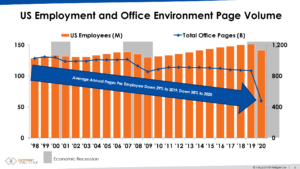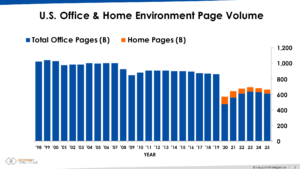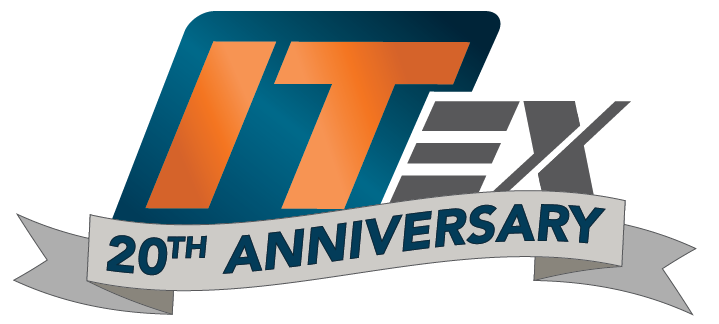There has been a lot of controversy and interest over one of the comments in a video that Marc Spring and I had regarding the amount of pages lost in our industry during the pandemic. As you can probably imagine Keypoint Intelligence has been tracking the page volume of the office for more than 20 years and the trends we have seen over time have been pretty consistent. One of the indicators that helps us is the correlation of the “US Employment Rate” to devices and page volumes in the office. Basically, as the employment rate increases, so has the pages and vice versa, as a top-level trend. During the past 20 years since we have been looking at this correlation, we have also seen the dramatic decline of pages during recessionary periods where of course employment has gone down as well as the pages. During these recessionary periods, usually 1 or 2 markets are dramatically affected such as the financial crisis in 2000 as well as 2007, where financial industries (and others that were affected such as real estate, etc), that made a significant impact in pages; fewer workers in the industries affected, fewer pages. The COVID impact was significantly different than any other, where it affected almost every industry. As you probably know from your own experience with COVID and all your customer’s offices essentially shut down across the country, a significant number of pages were lost, and our prediction is that a significant portion, will never come back.
The initial lockdown of 2020, the shift to remote work and mass job loss all had a profound effect on office print volume. In 2020 Keypoint Intelligence recorded a net print volume loss of as much as 60% in some of the initial months. Across the calendar year of 2020, print volume was down some 30% compared to pre-covid levels and 2021 is at a similar level.

The expected long term effect of the pandemic will be even greater as there are many more factors involved. Firstly, job loss was massive at the height of the lockdown. Reportedly 44 million jobs were lost in the US alone due to economic uncertainty. It is predicted that post pandemic, the new level of employment in the US will be 10% below that of prior. But this didn’t have the greatest effect on office print volume as the majority of jobs lost were in low income and not knowledge worker roles. It was the shift to remote work, the forced working from home rule, that really altered the pattern of office print. We have known for many years, that workers print more in an office environment than they would do at home. This is related to the quality and productivity of office equipment. Take that away and print levels are automatically reduced. In a home working environment, many didn’t have a printer and quickly found a work around. Workers did print at home, and we recorded also significant upsurge in home printing, in particular optional print either to combat “zoom fatigue” or to support pastime activities but this is a fraction of office print only.

At the same time, the pandemic accelerated the adoption of digital processes for many companies as a workaround and sped up the transition away from paper-based processes. Digital transformation is not new, in the IT age, we have been, and we constantly are striving to adopt processes that are better than prior and most of this is supported by IT. The pandemic provided a perfect test group for those cloud sceptics to suddenly accept, this can work. The pandemic also forced many companies to shift IT infrastructure into the cloud, workers shifting to virtual meetings as well as it often allowed organizations to reconsider their mindset on DX.
The Purpose of Place
For those of us that are resisters to change, or have been significantly disadvantaged by the pandemic, there is a valid case for getting back to “normal”. The only thing is, the new normal is not the same as the old one. We can already say now that office print volume is not going to return to pre-pandemic levels firstly because the mindset on the office as a location has shifted as well as Digital Transformation has given us a quantum leap forward that we don’t want to miss.
That more people will work from home in the future is a given. For large companies, the cost efficiencies are huge and from a worker perspective, the wellbeing aspects of working from home have been welcomed large scale. In addition, the US economy has the highest level of people employed in services. Add the environmental element coming from reduced commuting time and cost to that and it’s a no brainer. Except of course for the purpose of place. Offices and cities and even regions (think Silicon Valley) grew out of the desire for people and organisations to be near materials, around other creative people and important ideas and innovations. This has not gone away but the concept has changed. For true knowledge workers, that don’t require specific equipment or people interaction to complete their work, “the office” will no longer be a 9-5 residence. Instead, it will become a creative hub, for busy bees to meet and interact. For that, workers will need smarter buildings & smarter tools, and that must be the focus of our industry going forward. Provide the tools to make workers and companies smarter.
To find out more about our predictions and where the “New” opportunities are in the office, come to our pre-conference session during ITEX as well as the conferences during the show where you will learn more about the “why” you need to transform and diversify as well as the “where” to focus and “how to” get into these new markets.
For more information about our education lineup at ITEX, click here.
To register for ITEX, please click here. (Use Promo Code EARLYBIRDITEX to take advantage of discounted rates for a limited time!)
We look forward to seeing you there!

